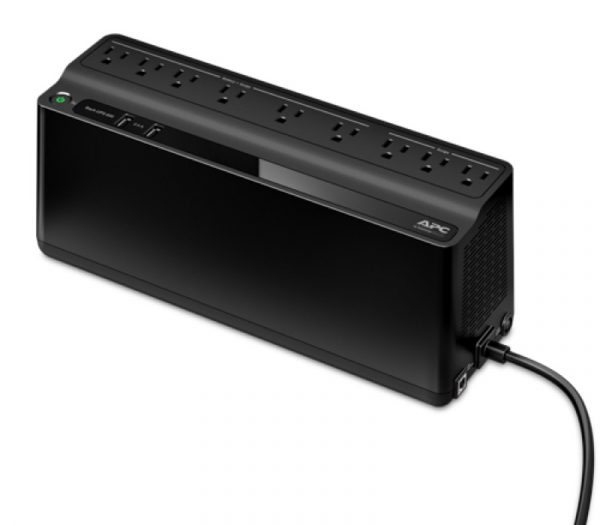
Despite the power-hungry gadget count in my home, I don’t have an uninterruptible power supply (UPS). I just never got around to it. Power outages aren’t very common where I live. However, my son has been doing a lot of writing for homework on the computer, and it would be a shame to lose his assignment if he didn’t save often in case of power failure. With that in mind, let’s take a look the APC Back-UPS BE850M2 uninterruptible power supply.
When I got the box, I noticed one thing: Backup power supplies are heavy!
Output
-
Output power capacity: 450Watts / 850VA
-
Max Configurable Power (Watts): 450Watts / 850VA
-
Nominal Output Voltage: 120V
-
Output Frequency (sync to mains): 50/60 Hz +/-1 Hz
-
Topology: Standby
-
Waveform type: Stepped approximation to a sinewave
-
Output Connections:(3) NEMA 5-15R (selector_surgetitle) (6) NEMA 5-15R (Battery Backup)
-
Transfer Time: 6ms typical : 10ms maximum
Input
-
Nominal Input Voltage: 120V
-
Input frequency: 50/60 Hz +/- 3 Hz (auto sensing)
-
Input Connections: NEMA 5-15P
-
Cord Length: 5ft ( 1.52meters )
-
Input voltage range for main operations: 92 – 139V
-
Number of Power Cords: 1
Batteries & Runtime
-
Battery type: Maintenance-free sealed Lead-Acid battery with suspended electrolyte : leakproof
-
Typical recharge time: 8hour(s)
-
Expected Battery Life (years): 2 – 5
-
Battery Volt-Amp-Hour Capacity: 84
-
Maximum Height: 5.47inches ( 139mm , 13.9cm )
-
Maximum Width: 12.87inches ( 327mm , 32.7cm )
-
Maximum Depth: 4.13inches ( 105mm , 10.5cm )
-
Net Weight: 9.04lbs. ( 4.1kg )
Here’s the top of the BE850M2. The first 6 outlets from the left can be powered by battery backup in case of power failure. Note the wider spacing for the middle three outlets for wall warts. The last three on the right are not on battery backup.
A closeup of the unit shows two USB ports. These are also powered in case of power failure.
On the side is a fault indicator light, circuit breaker switch, power cord (not removable) and a USB “data port”.
Why a USB port? APC features PowerChute, a Windows program for power and energy management. The program will perform periodic battery self-tests, summarize power problems (blackouts, electrical noise) and perform a “graceful, unattended operating system shutdown in the event of an extended power outage or computer power problem.” Since I don’t have a Windows computer, I could not test these features.
On the back, I found two hanging keyholes in case you want to mount your BE850M2.
It should probably be no surprise that backup power supplies are mostly battery. The BE850M2 comes with the battery in the compartment, but you need to plug the leads in.
Here’s a close-up of the BE850M2’s label.
One nice touch is the flat power plug with the cord that exits at an angle. Great for tight spaces.
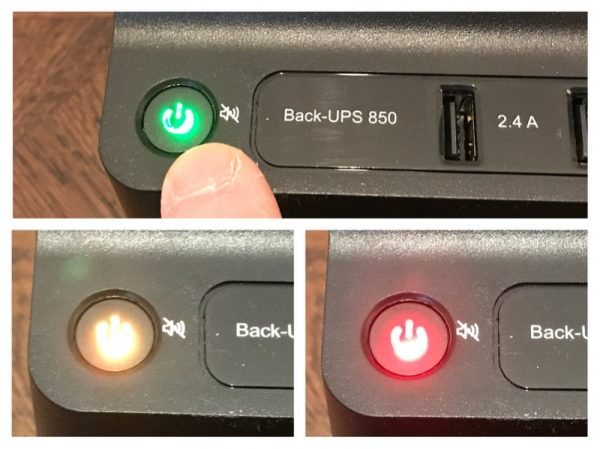 There’s only one visual indicator on the BE850M2. The power button doubles as a status indicator. Here, I’m setting the sensitivity. (Red is the default. Green is less sensitive to voltage or waveform fluctuations, and amber is highly sensitive).
There’s only one visual indicator on the BE850M2. The power button doubles as a status indicator. Here, I’m setting the sensitivity. (Red is the default. Green is less sensitive to voltage or waveform fluctuations, and amber is highly sensitive).
The million-dollar question is: How long will this power your gear in case of a power failure? It depends.
APC has a graph that plots runtime: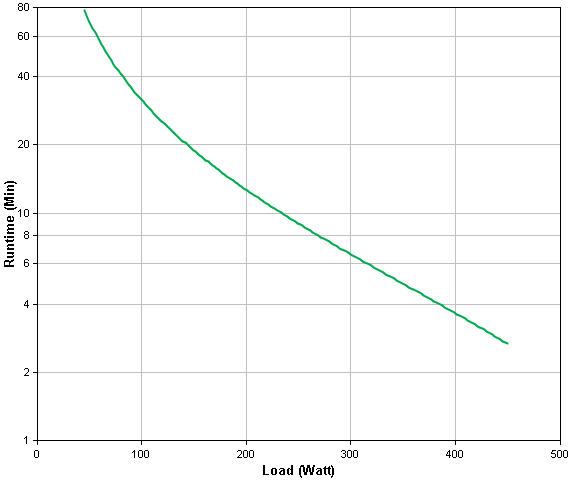
But for those of you who like charts instead, go check this page out instead. At full load, the BE850M2 will run for 3 min at 450 Watts. On the other end, a 50 Watt load will run for 1 hour and 9 minutes.
According to these charts, my son’s Mac Mini (85W draw) and monitor (19W draw) should be good to go for about 30 minutes.
To test this, I found an incandescent bulb running at nearly exactly 40 Watts and set up a GoPro on time lapse with a timer to see how long it the BE850M2 would run without main power.
It turns out the GoPro wasn’t necessary. The BE850M2 beeped to warn of near-shutdown after 93 minutes. The audible alert was a nice touch
Not many of us are going to be powering 40 Watt bulbs off a backup power supply, but the APC Back-UPS BE850M2 with USB power ports has plenty of outlets for most of your light to moderate duty needs. Now my son has one less excuse to lose his homework at the hands of the local utility.
UPDATE (Jan 21, 2017)
I tested the USB power output on “backup” power only. To do so, I devised this rig where I could dial in a specific current draw (in this example, 2.0A) and a timer that counted how many hours it would run for.
I clocked in 6.3 hours at 2.0A. Using a no-contact voltage probe, I detected that the AC outlets were live, but my particular probe had a difficult time detecting current. This probably has something to do with the fact that UPS units like these approximate an AC sine wave.
Source: The sample for this review was provided by APC. Please visit their site for more info and Amazon to order.
APC UPS Battery Backup & Surge Protector, 850VA Backup Battery Power Supply, BE850G2 Back-UPS with (2) USB Charger Ports
APC UPS Replacement Battery RBC17 Back-UPS Models BE650G1, BE750G, BR700G, BE850M2, BE850G2, BX850M, BE650G, BN600, BN700MC, BN900M, BVK950M2, BVN950M2 and Select Others
20% OffProduct Information
| Price: | $109.00 |
| Manufacturer: | APC |
| Retailer: | Amazon |
| Requirements: |
|
| Pros: |
|
| Cons: |
|

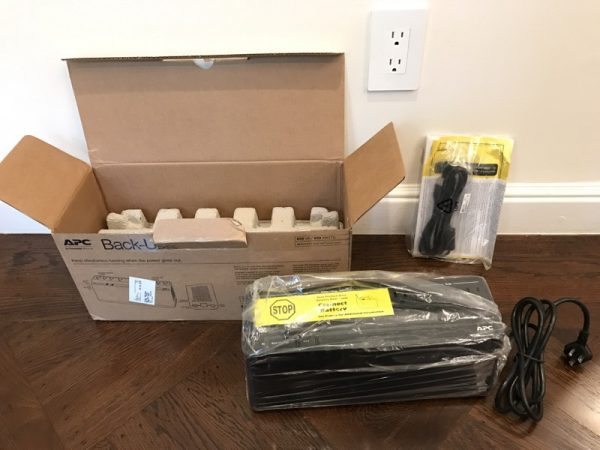
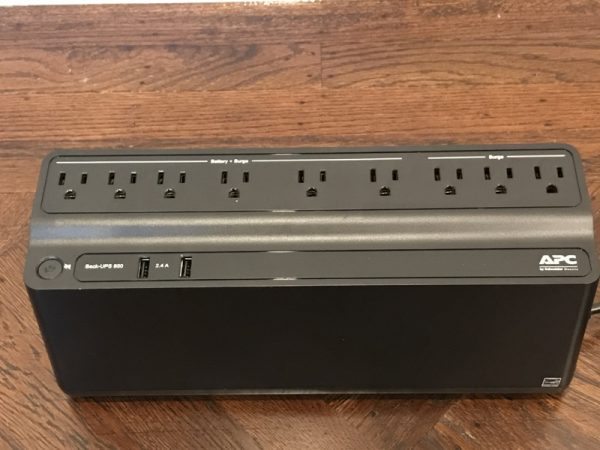
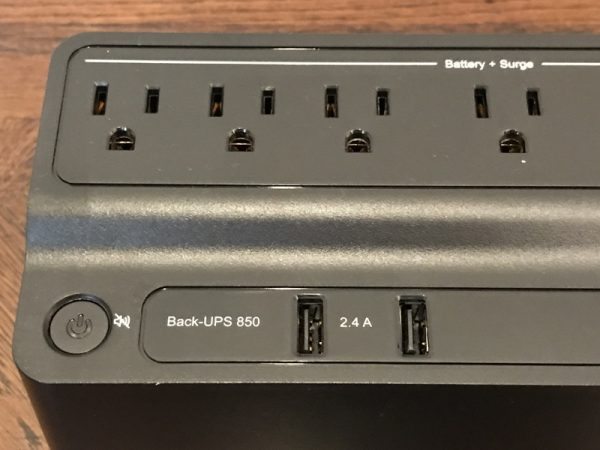
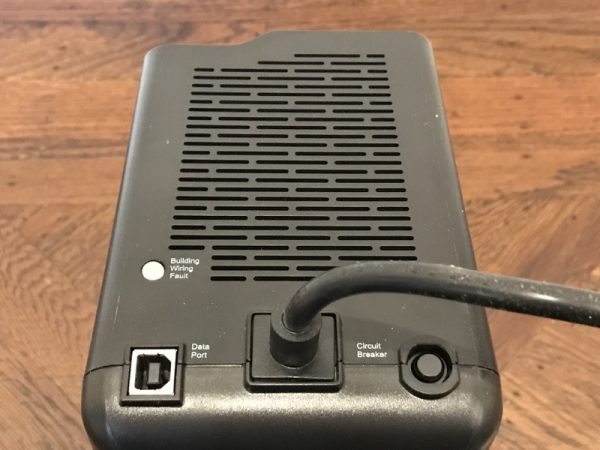
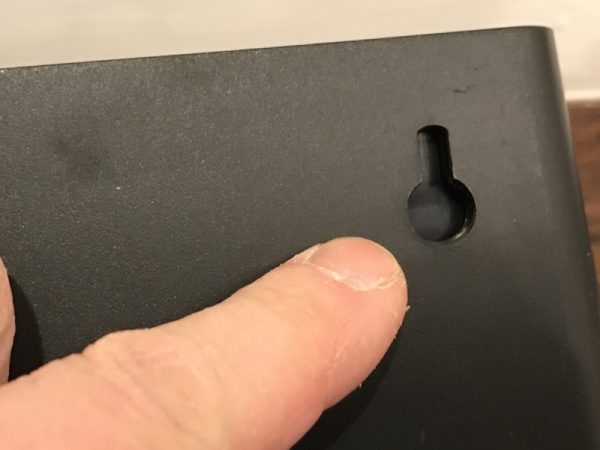
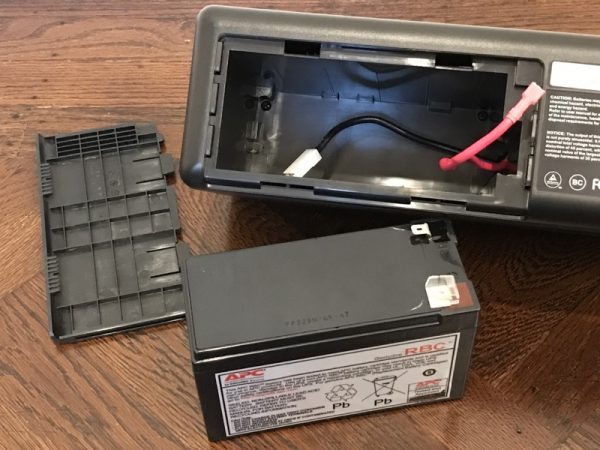
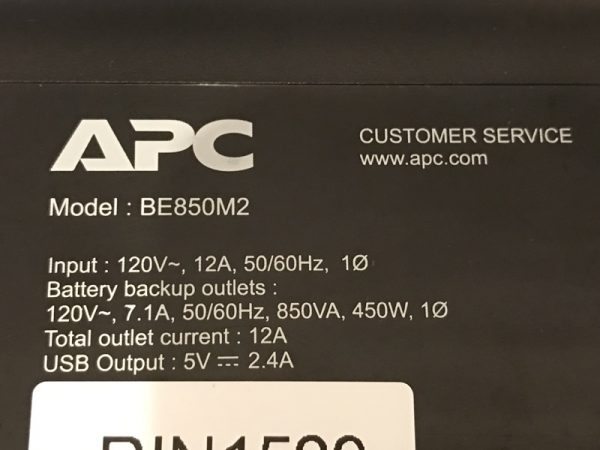
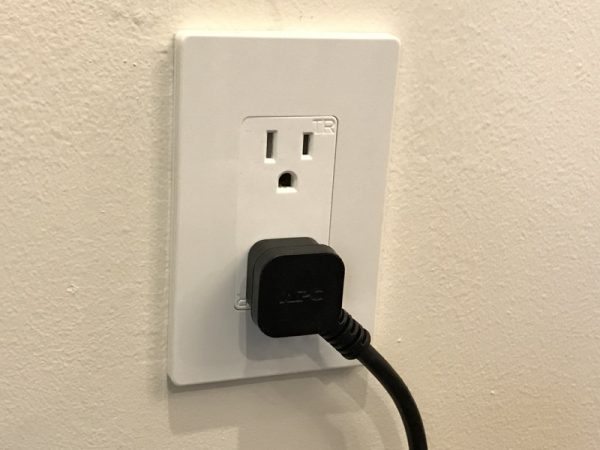
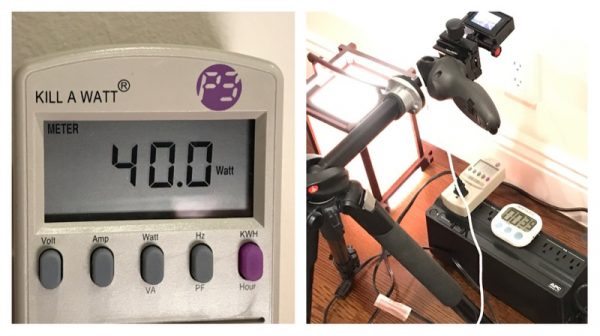
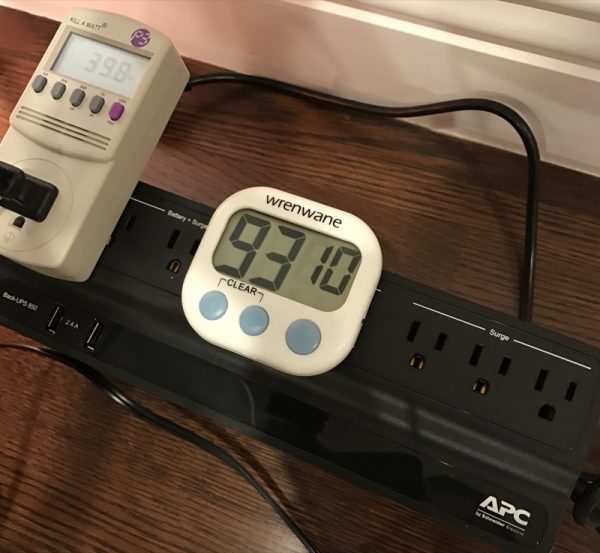
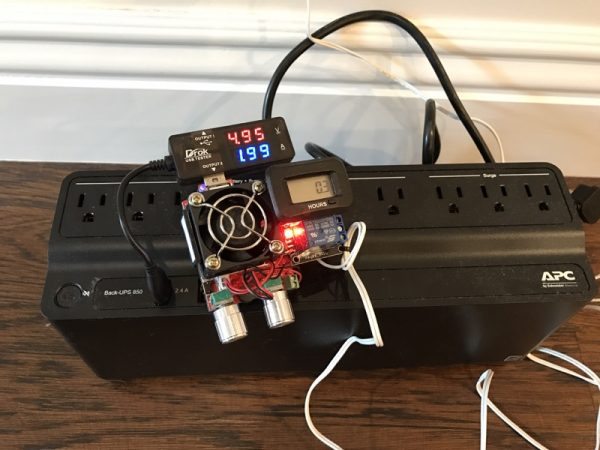


Gadgeteer Comment Policy - Please read before commenting
It’s great for a desktop computer, and also great for a NAS. You don’t want a NAS to lose power during a save activity.
Hi Andy-
I’m considering buying this unit for some network gear in my basement. The one thing I’ve been burned on before however, is auto-restart. Some cheaper UPSes require a button push to get back over to mains power after an outage. This is a deal killer for me.
What’s the behavior of this unit when power returns? Does it require intervention or are you simply back up and running? Also, can you silence the alarm? Thx.
From what I can tell, no intervention necessary.
Alarm silencing:
I read this from the manual
http://www.apc.com/salestools/AHUG-A52BFR/AHUG-A52BFR_R2_EN.pdf
“The Back-UPS is able to temporarily mute user correctable alarms such as: On Battery, Battery disconnected and Overload.
Other critical events such as Battery replacement and Charger notification can not be temporarily muted. The unit in these cases must be turned off.
During such alarms, a short press (less than 2 seconds) of the POWER button will temporarily mute the alarm until the condition has been reset. A short double beep will confirm that Quick Mute has been activated. Pressing the POWER button for more than 2 seconds will turn off the UPS.”
Thanks for the link to the manual. It looks like there is a method to shutoff the on-battery alarm using button presses. I consider this essential in a home installation.
Nothing worse than getting woken up from a dead sleep by a piercing beep. These things are supposed to make your life easier not worse.
I agree with the NAS comment. All 6 of mine are protected by an APC UPS. Besides power outage protection, the real utility of a UPS is line filtering and surge suppression. Years ago, the Public Utilites’s power transformer blew during a heat wave. Killed the motor for the Spa pump, but the rest of the spike was absorbed by the APC UPS.
I have been searching forever for a UPS that is capable of providing USB power only.
Could you do a test for me? If you power USB devices only during a power outage, does this thing run the inverter?
The reason is that the inverter is a terrible waste of energy — converting from DC to AC and running a fan — and it is not needed if there is no load on the AC plugs!
If it is possible to run it on battery power and have it giving juice to the USB plugs only, without the inverter on, it is my dream UPS.
I have read all the documentation from APC but no joy.
Cheers!
Commenter,
“Does this thing run the inverter”? Did you mean, can you power an inverter from USB?
Or did you mean, can you run USB powered devices from the BE850M2 only, in case of a power outage, and for how long?
It is my understanding that you can. Let me devise a test and I’ll get back to you.
Fantastic; thanks!
Sorry my comment was not clear.
When you are using the AC plugs, there is an inverter inside of the UPS that is converting (inverting) DC battery power to AC power. This is very inefficient and consumes a lot of the battery power.
When you have AC load connected, then this is of course a necessary evil.
If you have *only* USB loads connected, I am wondering whether the unit powers down the inverter or whether it is still running.
You should be able to tell the difference because the inverter will have a cooling fan on it. The unit *should* hum or produce a fan sound when it’s inverter is running — i.e. when AC loads are connected.
If you disconnect all AC loads and only connect a USB load, is the inverter still on?
All of this is assuming “power outage” conditions of course — i.e. not connected to the wall.
I hope that this makes more sense. Thanks again!
There is no audible hum or fans when the unit is running on backup power. Sorry.
The very nature of a UPS is to keep the battery fully changed at all times. From years of selling the things as a Manufacturer’s Rep I know that there are 2 types of UPS on the market on-line and off-line. An Enterprise level UPS like you would find in a server room is on-line, the A/C mains go to the battery and inverter which then provides power to the connected devices. The benefit is there is zero lag when there is a power outage, surge or spike. With a consumer grade UPS, or off-line, the A/C mains power the connected devices while charging the battery. In the event of an event, there is a very, very short delay in switching from A/C mains to the battery. Usually you’ll never notice, but Data Centers pay for top flight reliability.
And the cooling fan in thermostatically controlled by an internal sensor. These things get hot inside.
Interesting. Thanks for checking!
I guess that the only other way to test it would be to unplug it with no load whatsoever and see whether it discharges.
If it’s always running the inverter, it will discharge even with nothing plugged in. But if the inverter is powered down during a “no-load” scenario, it should be able to hold a charge indefinitely.
Weird that it is a USB-capable UPS but they do not publish a USB-load runtime!
I’m planning to build a USB runtime hour meter. I’ll give the runtime a shot. Of course there’s no practical way to check to see if the inverter is running. I can use an inductive voltage probe which really doesn’t draw power, to see if the AC side is pumping out volts.
I’ll probably have something cobbled up over the Christmas long weekend. Maybe.
Cool!!
If you do, I will watch this space for your results!!
I got 6.3 hours at 2.0A load, 5V USB. Plus, the AC outlets were “live” even without a load connected to them.
good thought about inverter for usb plugs…all my ups’s (apc and others) only have a/c outlets. one way to test (i think) wpuld be to check the voltage drop at battery terminals with usb load versus 40watt bulb via a/c outlet. i may try that with some alligator clips to a volt meter. i have 2 ups’s that i made external connectors for to run a larger battery (18 amp hour vs 9) so it will be a little easier to do that.
That is a fantastic idea!!
If you turn the backup off and unplug it, does it still provide power to the usb ports so you can charge a cell phone, or does the power button turn the usb ports off too?
The product literature says “Conveniently located USB port(s) allows you to charge and power your mobile devices (smart phones, tablets, portable gaming consoles, etc.) during power outages.”